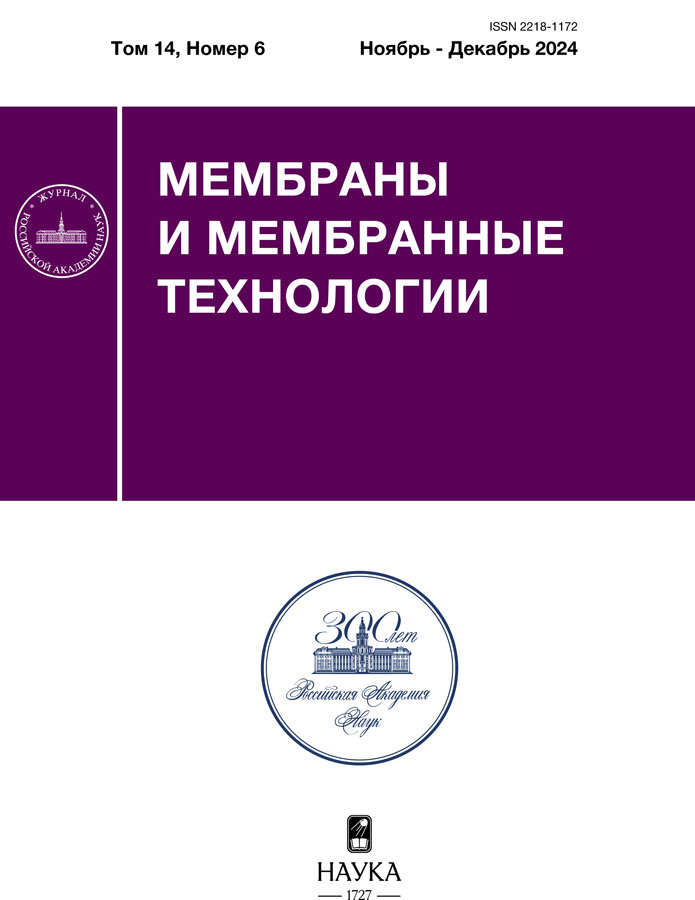Decomposition and concentration of sludge water by membrane electrolysis
- Authors: Vasyunina N.V.1, Dubova I.V.1, Druzhinin K.E.2, Gilmanshina T.R.1, Shubkina O.Y.1
-
Affiliations:
- Siberian Federal University
- LLC “Indust-PRO”
- Issue: Vol 14, No 6 (2024)
- Pages: 527-533
- Section: Articles
- URL: https://kld-journal.fedlab.ru/2218-1172/article/view/684839
- DOI: https://doi.org/10.31857/S2218117224060098
- EDN: https://elibrary.ru/MAEIOR
- ID: 684839
Cite item
Abstract
The article discusses the possibility of using electrodialysis for processing weak aluminate solutions for the purpose of causticization and obtaining strong alkaline solutions is being studied. A three-chamber electrodialysis cell of our own design is described. The cell uses heterogeneous cation exchange membranes MK-40; titanium alloy VT1-0 is used as the cathode and anode material. Electrodialysis was carried out at an interpolar distance of 3–5 cm and a current density of 0.5–3.0 A/dm2 to obtain cathodic (concentrated caustic alkali solution) and anodic (aluminum hydroxide and desalinated solution) products. The optimal operating parameters for the process of electrodialysis concentration of an aluminate solution were selected – the current density is about 2 A/dm2 with an the interpolar distance of 4 cm. It was determined that the soda content in the solution within an hour decreases from 55 to 25–30% at various operating parameters of the electrolylysis process. The degree of concentration of total alkali in the solution at the selected process parameters after an hour reaches 1.40–1.45.
Full Text
About the authors
N. V. Vasyunina
Siberian Federal University
Author for correspondence.
Email: gtr1977@gmail.com
Russian Federation, Krasnoyarsk
I. V. Dubova
Siberian Federal University
Email: gtr1977@gmail.com
Russian Federation, Krasnoyarsk
K. E. Druzhinin
LLC “Indust-PRO”
Email: gtr1977@gmail.com
Russian Federation, Krasnoyarsk
T. R. Gilmanshina
Siberian Federal University
Email: gtr1977@gmail.com
Russian Federation, Krasnoyarsk
O. Yu. Shubkina
Siberian Federal University
Email: gtr1977@gmail.com
Russian Federation, Krasnoyarsk
References
- Cassano A., Molinari R., Romano M., Drioli E. Treatment of aqueous effluents of the leather industry by membrane processes: a review, J. Membr. Sci. 181 (2001)111–126.
- Qin J.J., Oo M. H., Wai M. N., Ang C.-M., Wong F. S., Lee H. A dual membrane UF/RO process for reclamation of spentrinses from a nickel-plating operation — a case study, WaterRes.37(2003)3269–3278.
- Milačič R., Zuliani T., Ščančar J. Environmental impact of toxic elements in red mud studied by fractionation and speciation procedures, Sci. Total Environ. 426 (2012)359–365.
- Smith P. The processing of high silica bauxites — review of existing and potential processes, Hydrometallurgy 98(2009)162–176.
- Дружинин К.Е., Васюнина Н.В., Немчинова Н.В., Гильманшина Т.Р. Очистка отходящих газов печей спекания с использованием подшламовой воды в качестве газоочистного раствора. Экология и промышленность России. 2020. Т. 24. № 3. С. 4–9.
- Strathmann H. Electrodialysis, a mature technology with a multitude of new applications, Desalination 264 (2010) 268–288.
- Yan H., Wu C., Wu Y. “Separation of alumina alkaline solution by electrodialysis: Membrane stack configuration optimization and repeated batch experiments,” Separation and Purification Technology 139, 78–87 (2015). https://doi.org/10.1016/j.seppur.2014.11.004
- Haydarov A. A. et al. Obtaining of alkaline from aluminate solution by electrodialysis method //Azerbaijan Chemical Journal. 2023. № 2. С. 154–162.
- Yuzer B. et al. Optimal performance of electrodialysis process for the recovery of acid wastes in wastewater: Practicing circular economy in aluminum finishing industry //Chemical Engineering Journal. 2022. Т. 434. С. 134755.
- Липин А. Г., Липин А. А. Концентрирование раствора нитрата аммония в электромембранном аппарате // Энергоресурсоэффективные экологически безопасные технологии и оборудование. 2019. С. 11–13.
- Быков В. И. и др. Электродиализ: история и перспективы развития //Вестник технологического университета. 2021. Т. 24. № 7. С. 5–10.
- Hu B., Mu Z. D. “Treatment of wastewater from alumina plant by electrodialysis,” IOP Conf. Ser.: Earth Env. Sci. 295 (3), 1–6 (2019). https://doi.org/10.1088/1755-1315/295/3/032090
- Lainer Y. A., Gorichev I. G., Todorov S. A. Aluminum hydroxide nucleation kinetics and mechanism during the electrodialysis decomposition of aluminate solutions // Russian Metallurgy (Metally). 2008. Т. 2008. С. 301–305.
- Vetchinkina T. N., Tuzhilin A. S., Balmaev B. G. Decomposition and Concentration of Aluminate Solutions by Electrodialysis // Russian Metallurgy (Metally). 2022. Т. 2022. №. 12. С. 1511–1517.
- Yaxian Zhanga, Qi Shia, Muxi Luoa, Hongtao Wanga, Xuejiao Qia, Chia-Hung Houd, Fengting Lia, Zisheng Aie, Jose Tacares Araruna Junior. Improved bauxite residue dealkalization by combination of aerated washing and electrodialysis // Journal of hazardous materials. 2019. Т. 364. С. 682–690. https://doi.org/10.1016/j.jhazmat.2018.10.023
- Yan H., Wu C., Wu Y. Separation of alumina alkaline solution by electrodialysis: Membrane stack configuration optimization and repeated batch experiments // Separation and Purification Technology. 2015. Т. 139. С. 78–87.
- Иванов А.А. Электропроводность водных растворов кислот и гидроксидов // Известия ВУЗов. Химия и химическая технология. 1989. Т. 32 (10). С. 13–16.
- Машина А. Н., Артемкина Ю. М., Щербаков В. В. Температурная зависимость энергии активации электропроводности водных растворов сильных электролитов // Успехи в химии и химической технологии. 2017. Т. 31. № 4 (185). С. 49–51.
- Васюнина Н.В., Дубова И.В., Дружинин К.Е., Гильманшина Т.Р. Концентрирование слабощелочных алюминатных растворов методом электродиализа // Цветные металлы. 2024. № 4. С. 9–14.
Supplementary files













